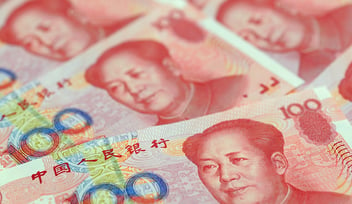China has been doing everything in its power for years to catch up with the United States as the biggest economy in the world. In a bid to reduce dependence on the US dollar (USD) and assert its influence on trade and finance, China has gone to great lengths to increase the international use of its currency, the renminbi (RMB). We take a look at efforts made to augment its global standing, as well as the obstacles that still lie in Beijing’s path.
While China is the world’s second largest economy by GDP and its largest exporter, its currency is not yet of global significance. In fact, it does not feature among the most traded currencies in the world. Its position on the forex is hardly spectacular. According to research conducted by the BIS and the IMF, the currency’s share on the international forex market is only 4.3%. Actually, that picture is still too rosy, because you have to take into consideration the principle of double counting as two currencies are involved in each transaction. The dollar’s market share in this respect currently stands at 88.3% and it remains the world’s largest reserve currency by some margin.
Described by former French president Valéry Giscard d’Estaing as an “exorbitant privilege”, the dollar’s dominance as the global trade and reserve currency offers the United States multiple benefits, from lower borrowing costs and reduced foreign exchange risk, to virtually no threat of a balance of payments crisis. By promoting the renminbi as a global currency for trade, investment and foreign exchange reserves, China aims to avail of some of these advantages, while increasing its economic policy autonomy.
But the road to internationalisation is long, particularly for a currency and economy as heavily regulated as China’s. With tight controls on cross-border capital flows and onerous regulation, the country has some way to go before realising its world currency ambitions. Having launched multiple recent initiatives to boost internationalisation, China has nonetheless let its intentions be known. But how successful have these been thus far?
Why is China focused on RMB internationalisation?
Pursuing the renminbi’s internationalisation is of evident benefit to China, from both a political and economic standpoint. Though it has been on the cards for some time, efforts have intensified since the 2008 financial crisis, which exposed many countries’ dependence on the dollar. But what’s at the heart of this push for internationalisation?
Dollar trap
Despite China’s immense trade volumes, the renminbi still accounts for just 2% of global payments, is involved in approximately 4% of forex trades internationally and makes up around 2% of foreign currency reserves globally. By contrast, the US dollar possesses a 40% share of global payments, 61% of official foreign exchange reserves and is involved in over 88% of forex trades. In a highly asymmetric International Monetary System (IMS), the dollar is still by far the dominant global currency when it comes to investment, invoicing and reserves.
This has led to a phenomenon known as the “dollar trap”, whereby countries and currency areas find themselves overly reliant on the dollar’s exchange rate, with central banks managing their national monetary policy in accordance with the Fed. To this day, China maintains a “crawling” peg to the US currency. A major proportion of its liabilities and foreign exchange reserves are denominated in USD, while its assets are primarily denominated in RMB. The former’s depreciation can therefore bear a significant adverse impact on China. This came to the fore during the 2008 financial crisis and ensuing “credit crunch”, when the dollar was in short supply, before depreciating in value as a result of quantitative easing policies.
In 2009, then governor of the People’s Bank of China, Zhou Xiaochuan, launched an indirect barb at the dollar’s dominance, citing the need for an “international reserve currency” to “secure global financial stability”. He alluded to the idea of a super-sovereign reserve currency, disentangled “from economic conditions and (the) sovereign interests of any single country”. A super-sovereign reserve currency, composed of a basket of the world’s main currencies (each weighted by GDP share), is certainly a tantalising prospect for China, but remains a pipe dream for now. This has left the country to pursue its goal of securing greater renminbi use internationally, accelerated with the launch of the offshore renminbi (CNH).
Extending Beijing’s influence
Commenting on the rise of geopolitical tensions in the wake of the Covid-19 pandemic in 2020, NATO Secretary General Jens Stoltenberg remarked that China’s ascent was creating a fundamental shift in “the global balance of power, heating up the race for economic and technological supremacy.” Indeed, over the past thirty years, it is no secret that China’s meteoric rise as an economic, military and technological powerhouse has been nothing short of astounding. Having developed boundless manufacturing capacity and greatly stepped up its military modernisation and technological innovations, Beijing sees the country’s relative monetary insignificance as a major shortcoming.
Beyond an extension of the country’s political influence, greater renminbi prevalence would offer China the benefit of reduced costs in cross-border trade and a significant reduction in currency risk. Given the sheer volume of global goods that move through China but are invoiced in USD, this alone would represent a considerable improvement for the country’s standing in international trade. The ability to accrue greater seigniorage (revenue from the issue of money) and borrow large quantities from abroad, both cheaply and in its own currency, would also be of great strategic benefit to the Chinese economy. That said, capital controls, limited RMB convertibility and a not-yet mature financial sector are still major roadblocks ahead. This inevitably begs the question, just how far is Beijing willing to go?
|
Did you know? Used as a mechanism to maintain stability, a “crawling peg” refers to a band of rates around which a currency with a fixed exchange rate is allowed to fluctuate. The currency is routinely bought and sold in order to maintain a rate within the authorised range. |
How is China pursuing RMB internationalisation?
To establish the renminbi as a major international currency for investment, invoicing and foreign exchange reserves, China has undertaken a series of impressive initiatives over the past decade or so.
As part of the country’s 13th five-year plan, adopted by the People’s National Congress for 2016–2020, China’s Politburo Standing Committee explicitly outlined its currency ambitions by committing to “steadily promote RMB internationalisation and see RMB capital go global”. Broadly speaking, China’s subsequent efforts have consisted of making the renminbi not only a credible medium of exchange – by attempting to firmly establish it as a global trade currency for goods and services – but also reinforcing its position as a store of value. This means making the renminbi a genuine investment currency for asset purchasing, as well as a truly alternative foreign reserve currency to the dollar.
To achieve these goals, China will need to:
- relax its capital controls;
- allow greater currency convertibility;
- reform its financial sector.
The country has made some impressive strides in these areas, but it will take a lot for the renminbi to hoist itself up to a monetary position that reflects China’s wider economic status. What has the Chinese government done to further pursue its RMB internationalisation objectives so far?
Concrete actions undertaken by China:
1. Currency swap agreements
- They boost a currency’s liquidity by providing other countries or currency areas access to it.
- They reduce the effects of exchange rate fluctuations.
- China has signed currency swap agreements with over 36 central banks over the past ten years or so.
2. Offshore trading
- From 2009, China has also facilitated overseas trade settlements in renminbi, or “offshore renminbi” (CNH), following the success of a limited pilot initiative.
- This has resulted in clearing centres being established outside the mainland, boosting China’s cross-border trade settlements significantly.
- This success is to be tempered by the fact that nearly three quarters of offshore renminbi clearing occurs in Hong Kong, with its strong ties to mainland China.
3. Inclusion in the IMF’s SDR basket
- Boosting its profile as a reserve currency, the renminbi was also included in the IMF’s Special Drawing Rights (SDR) basket in 2016, alongside the dollar, euro, yen and pound sterling.
- The IMF maintains the SDR as a supplement to members’ foreign currency reserves, acting as a means of increasing liquidity levels in the global economy in times of shortage.
- Inclusion in the SDR depends on the dual criteria of large export volumes and a “freely usable” currency, with many of China’s recent reforms designed to satisfy the latter.
4. RMB-denominated bonds
- Also known as “dim sum bonds”, China has allowed these to be purchased outside mainland China, where they are subject to fewer restrictions.
- Primarily issued in Hong Kong, dim sum bonds allow foreign investors to acquire RMB-denominated assets, while avoiding Chinese capital controls.
- Investors interested in holding debt in renminbi can avail of this function, which has seen a surge in interest since its introduction.
5. Foreign direct investment
- From 2011 onwards, China has also liberalised foreign direct investment (FDI) through lawfully obtained offshore renminbi or yuan (CNH).
- An updated Foreign Investment Law in 2020 further eased procedures, notably shortening the “negative list” of industries deemed to be restricted or prohibited.
- Cross-border remittance undertaken by “foreign-investment enterprises”, or FIEs, was also further relaxed, with foreign investors able to remit outside of China in RMB or foreign currencies at will.
6. Free trade zones (FTZs)
- Beginning with Shanghai in 2013, China has prioritised the creation of free trade zones, with Guangdong, Tianjin, and Fujian provinces elected as the locus of the FTZ pilot.
- Designed to attract foreign investment, notably through eased regulations within that specific jurisdiction, China’s FTZs offer advantages like duty-free import and export.
- Beyond stimulating foreign trade, FTZs are used as testing grounds for wider reforms in areas like customs clearance and foreign exchange settlement.
In addition, China has pursued further RMB internationalisation through the establishment of its Cross-border Interbank Payment System (CIPS), set up in 2015 as an alternative to the pervasive SWIFT network. The payments processing infrastructure experienced a near-80% increase in volumes between 2017 and 2019, with approximately RMB 26 trillion handled directly through it. Unsurprisingly, its use ballooned in countries directly involved in China’s Belt and Road Initiative (BRI), a major foreign policy and infrastructural undertaking, which follows the path of the historic Silk Road. The BRI represents an exercise in “soft power”, seeking to further strengthen China's position on the international stage. Significantly increasing the RMB’s cross-border transactional use in countries involved in the initiative would be a major boon to Beijing. Similarly, the recently ratified Regional Comprehensive Economic Partnership (RCEP) is a unique chance for China to take the lead on multilateral trade policy, without elicting tension from other major economic heavyweights. The agreement forms a new trading bloc between China and fourteen additional nations, which include the ASEAN countries, as well as Australia and New Zealand. It is yet another opportunity for China to promote RMB settlement in international trade, given the major investment projects the deal will inevitably give rise to.
|
Did you know? China’s central bank, the People’s Bank of China (POBC), maintains a “managed floating exchange rate regime”. This means the POBC adopts a more interventionist stance than many western central banks and the exchange rate doesn’t float quite as freely. Rather, the POBC communicates a desired exchange rate to forex market operators, who act accordingly. Market developments are regulated, with the aim of orienting the exchange rate towards a specific target. |
How successful have internationalisation efforts been?
To develop “market thickness” and firmly cement the renminbi’s status as a favourable currency for invoicing, investment and foreign exchange reserves, China still has its work cut out for it. Further liberalisation of capital controls, greater convertibility and wider financial sector reforms will be needed. But what impact have recent reforms already had? And what are the potential roadblocks on the path that lies ahead?
According to the Triennial Central Bank Survey on global foreign exchange markets, published by the Bank of International Settlements (BiS) in 2019, the RMB still accounts for only around 4.3% of forex operations worldwide, a comparatively low figure. That said, China’s currency accounted for less than 1% as recently as 2010, which suggests that recent internationalisation efforts have been gaining considerable traction. Similarly, while the renminbi may account for just 2% of foreign currency reserves at present, optimistic forecasts predict that this figure could reach between 10% and 20% by 2030 as the currency gains more ground on the forext market. When it comes to the settlement of international trade, progress has been even more impressive. In 2009, the percentage of Chinese foreign trade conducted through RMB was negligible. By 2015, the figure had already exceeded 15%.
But, for all the attention garnered by infrastructural projects and overseas trade deals, China may still have to devote a good deal of energy to deadlocks of a more fundamental nature. Above all else, the country’s practice of strict capital controls hinders financial market development, as well as broad renminbi use beyond Chinese borders. Liberalising these controls would ease capital flows in and out of China, but also lead to greater financial instability and volatility, which, as recent history has shown, Chinese authorities are not yet ready to embrace. In August 2015, for example, when China devalued the renminbi, the country quickly implemented strict capital controls to stave off any risk of large-scale capital flight. While it was successful in achieving this goal, the move dealt a considerable blow to international confidence in the Chinese currency and the effect was a significant reduction in RMB cross-border settlement. From an all-time high of RMB 2.09 trillion in 2015, international RMB trade settlement subsequently dipped to 994 billion in the first quarter of 2017. Incremental changes look set to continue, however, as many analysts regard the Chinese financial system as not yet mature enough for sweeping capital control reforms.
Arguably more peripheral concerns over the renminbi’s international development include issues like geopolitical antagonisms, which have recently accumulated. Reputational risk and the image of the RMB as a stable and reliable alternative currency could be impacted by ongoing tensions in the region. This is of special significance given that recent RMB-denominated trade settlement progress has been concentrated, to a large degree, in Asia and countries closely associated with the BRI initiative. China’s image abroad is crucial and any possible tensions, may prove harmful to rapid RMB internationalisation. In the same vein, it remains unclear whether territorial dispute in the South China Sea or recurring tensions along the Indian border will bear a direct impact on investment or RMB trade settlement in a meaningful way over time.
Despite some analysts’ concerns over a slowdown in growth as China progresses towards its goal of becoming a “moderately prosperous” society, economic growth in the country is bound to be strong over the next ten years. Heightened renminbi use internationally should coincide with this, as it becomes an increasingly significant currency for investment, invoicing and foreign exchange reserves outside mainland China.
China has made considerable efforts to expand renminbi use in recent years, beginning with the creation of the offshore renminbi (CNH). Endeavours to augment foreign interaction with the renminbi in trade settlements, from the issue of dim sum bonds to the establishment of FTZs, have also garnered impressive initial results, while ongoing multilateral initiatives like the RCEP, or China’s own BRI, are a chance for the country to promote renminbi use in an unprecedented manner. However, an insufficiently mature financial system, continued capital control restrictions, limitations on RMB convertibility and issues around the country and currency’s image hinder the internationalisation process.
Topics






